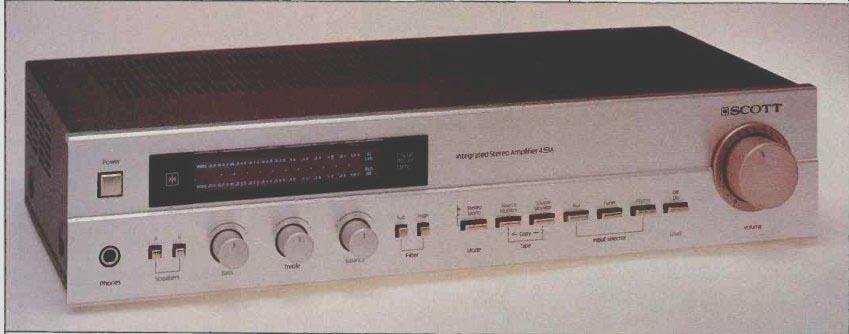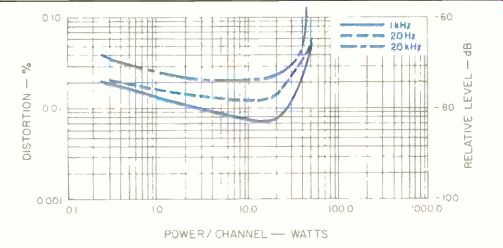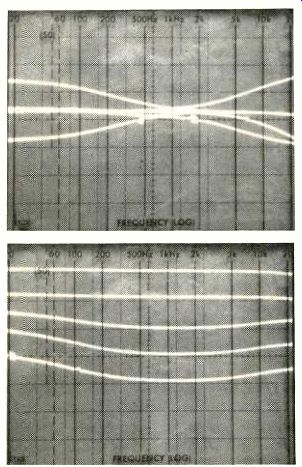
Manufacturer's Specifications
Power Output: 45 watts per channel, 8-ohm loads, 20 Hz to 20 kHz.
Rated THD: 0.04%.
Rated IM: 0.04%.
Damping Factor: Greater than 60.
Frequency Response: Phono, RIAA ±0.5 dB; high level, 20 Hz to 20 kHz, ±0.5 dB.
Input Sensitivity: MM phono, 2.5 mV; high level, 150 mV.
Phono Overload: 180 mV.
Tone Control Range: Bass, ± 10 dB at 100 Hz; treble, ± 10 dB at 10 kHz.
Subsonic Filter:-3 dB at 18 Hz, 6 dB/octave.
High-Cut Filter:-3 dB at 7 kHz, 6 dB/octave.
Loudness Contour (at-30 dB): + 3.5 dB at 10 kHz, + 7 dB at 100 Hz.
S/N: Phono (ref. 10-mV input), 80 dB; high level, 95 dB.
Power Requirements: 120 V, 60 Hz, 230 watts.
Dimensions: 16.9 in. (43 cm) W x 3.46 in. (8.8 cm) H x 7.95 in. (20.2 cm) D.
Weight: 13.64 lbs. (6.2 kg).
Price: $264.95.
Company Address: 20 Commerce Way, Woburn, Mass. 01888.
H. H. Scott's 438A integrated amplifier includes many of the features of Scott's top-of-the-line models. Among them are dual fluorescent auto-range peak-hold power meters, two tape monitor functions, a d.c.-configured output-capacitorless power amplifier stage, loudness contour, electronic circuit protection, subsonic and high-cut filters, plus conventional bass and treble controls.
The power on/off pushbutton is at the upper left of the panel, and just to its right are the dual, peak-reading fluorescent power-output meters which, besides providing peak hold, offer extended dynamic indicating range. When listening to low-level outputs, maximum scale indications are 1 watt. When volume levels are increased beyond that level, full scale reading becomes 100 watts, automatically. A stereo phone jack is below the on/off switch, and just to its right are a pair of speaker-selector buttons. Rotary bass, treble and balance controls come next, followed by subsonic and high-cut filter on/off pushbuttons. Further to the right, seven rectangular pushbuttons handle mono/stereo selection, the two tape monitor loops (including dubbing from tape 2 to tape 1), program source selection (AUX, tuner, phono), and activation of the loudness contour control. A large, calibrated volume-control knob is at the extreme right end.
The rear panel is equipped with the usual input and tape-out jacks, a ground terminal for turntable chassis grounding, two sets of spring-loaded speaker-cable connection terminals, and three convenience a.c. outlets. Before considering the purchase of this amplifier, you should be aware of a notice that was affixed to the inside cover of the owner's manual. It states that the 438A is designed to drive a total loudspeaker load of not less than 6 ohms per channel. This rules out operating two sets of speakers at one time (one pair in each of two rooms) unless you use a pair of 16-ohm speakers. (Even two pairs of speakers rated at 8 ohms would yield a net impedance of 4 ohms if both pairs were connected to the output stages simultaneously.) This admonition also rules out using 4-ohm impedance speakers.
However, as I found out during the bench testing, the limitation applies only if you operate the amplifier at or near its rated output level. At low listening levels, 4-ohm speaker loads caused no damage to the sample. Still, it seems to me that any integrated amplifier ought to be able to operate with 4-ohm loads these days, since so many good speaker systems have that rated nominal impedance. In fact, some manufacturers are making a point of the fact that their amps can handle 2-ohm loads safely.
Measurements
The Scott 438A delivered 48 watts per channel at mid-frequencies for its rated THD of 0.04% (Fig. 1). At the 20-Hz test point, it delivered exactly 45 watts, as specified, for that same THD level. At 20 kHz, however, the amplifier was able to deliver only 42 watts at 0.04%. When input signals were increased in level to produce the rated 45 watts at that high frequency, THD rose to 0.2%. SMPTE IM at rated output was also higher than specified, measuring 0.5%, though it did decrease to the rated 0.04% when output levels were backed off to 40 watts per channel. CCIF IM measured 0.01% at rated power output, while IHF IM was a satisfactorily low 0.035%. Figure 1 shows how THD produced by this amplifier varies with power output at low, mid- and high frequencies. Damping factor, measured at 50 Hz, was 40.
Dynamic headroom measured 0.6 dB, which means that, at mid-frequencies, short-term power peaks as high as 51 watts or so can be handled without audible evidence of clipping. The 438A consumed 30 watts of power when idling and around 220 watts with both channels delivering rated power on a continuous basis.
Phono frequency response deviated from the RIAA play back curve by +0.6 dB at 15 kHz, by +0.4 dB at 100 Hz and buy a full + 1.0 dB at 400 Hz (using 1 kHz as a zero reference point). Frequency response through the high-level inputs of the amplifier extended from 6 Hz to 40 kHz for a 1.0 dB roll-off and from 5 Hz to 55 kHz for the-3 dB cutoff points. Figure 2, a 'scope photo of a spectrum analyzer multiple sweep, depicts the maximum boost and cut characteristics of the bass and treble tone controls. The action of the gently sloping high-cut filter is also superimposed on this 'scope photo, and, as you can see, this filter does little more than could be accomplished by a moderate "cut" setting of the treble control. It was not possible to show the action of the subsonic filter, since its action begins below 18 Hz and this spectrum analyzer sweep runs from 20 Hz to 20 kHz. Separate meter measurements confirmed that the low cut or subsonic filter behaved pretty much as specified.
Input sensitivity and signal-to-noise measurements were all made in accordance with EIA (IHF) Amplifier Measurement Standards, and results are not easily compared with Scott's published specifications. Specifically, phono S/N was measured with an input of 5 mV (at 1 kHz) and with the master volume control adjusted to deliver 1 watt of output.
Under those conditions, A-weighted S/N was a satisfactory 77 dB. With a signal of 0.5 V fed to the high-level inputs and volume control once more adjusted to deliver 1 watt to the speaker loads, high-level signal-to-noise measured 81 dB while residual noise (volume control at minimum) was 84 dB below 1 watt. Input sensitivity for the phono input was 0.34 mV (for 1-watt output), and phono overload measured 180 mV, exactly as claimed. Input sensitivity for the high-level inputs was 25 mV for 1-watt output. The action of the loudness contour circuit is illustrated in Fig. 3 and is typical of this type of loudness compensation circuitry.

Fig. 1--Power output vs. THD.

Fig. 2--Tone control characteristics.
Fig. 3--Loudness contour characteristics.
Use and Listening Tests
While in my opinion the best thing that the Scott 438A has going for it is its price, the unit does offer a remarkable number of useful features and controls normally found on higher-priced, higher-powered models. Given a pair of high-efficiency speakers (having an impedance of 8 ohms), this amplifier will produce a surprising amount of clean sound, but don't try to push it beyond its limits. I did very much like the power meters, if for no other reason than that they gave me a good indication of just how far I could push the amp without running into overload. The auto-ranging feature was nice, too, especially since the 438A is likely to end up in systems whose owners are not looking to produce levels of 110 dB SPL in th6ir listening room.
(Adaped from Audio magazine, Aug. 1983)
Also see:
Scott Model R-376 AM/FM Stereo Receiver (Equip. Profile, June 1977)
Scott (H. H. Scott) Model 477 AM/FM Stereo Receiver (Oct. 1972)
Scott R77S AM/FM Stereo Receiver (May 1975)
= = = =